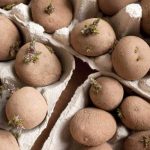This year I managed to fill three large hessian sacks with spuds for storage and we’ve been tucking in to them every other day as required. It’s very handy to have them there, waiting patiently in the garage for their moment of destiny in the kitchen.
I have to admit however that we’ve lost more than the normal number of spuds to pest damage this year (particularly among the main crop varieties). This is maddening, particularly since you don’t generally know that the spud is destroyed until you’ve gone to the bother of peeling it (and then discover a little network of cavities inside it, that render the potato inedible).
The two main pests of potatoes are slugs and wireworms—partners in slime. The wireworms are typically at the vanguard of these attacks—they are small wire-like worms that bore tunnels in to potatoes, making tiny holes on the surface. The more opportunistic slugs follow, using the same holes to gain access to the spud. Getting your main crop potatoes out of the ground as early as you can is the main organic method of prevention for both these pests.
That issue aside, the spud is an incredible hardy foodstuff that in general stores very well and we’ve enough potatoes to take us right through to March or so. It makes sense to check in every now and then on any stored food that you have squirrelled away to make sure that everything is in order. A rotting spud can quickly take out all the spuds around it, and before long the whole crop can turn to a squidgy mush. Removing the occasional rotting spud early on will prevent this from happening.
Sprouting in storage is normal and not a huge deal—in fact, the process of chitting them in spring before planting is encouraging them to do what some of my spuds have done quite naturally in storage. All the same, it’s no harm to rub off the sprouts and make sure the spuds aren’t soft or green before eating.
Grow, Cook, Eat
Our brand new grow/cookbook, called Grow, Cook, Eat (A GIY guide to growing and cooking your own food) is out now. Written by yours truly, it features seasonal contributions and recipes from over 35 of our favourite chefs, cooks and growers including Hugh Fearnley Whittingstall, Dylan McGrath, Donal Skehan, Darina Allen, Neven Maguire, Rachel Allen and Clodagh McKenna. Available from all good book stores and from the GIY website at www.GIYireland.com. RRP €25.
Things to Do This December
As you clear remaining crops from your veggie patch, dig the beds over and add well rotted compost or manure. Get Educated—book yourself on a course! Start planning what you would like to grow next year and work out what crop rotation system you are going to use. Study seed catalogues carefully before deciding on the best varieties to grow. Start a Compost corner or heap. Keep an eye on your stored veggies and discard anything that’s rotting. Collect and store leaves in bags to make leaf mould or use as cover for bare soil.
Sow
If you haven’t already done so plant garlic—it should be in the soil by the shortest day of the year. Bring herbs like mint, chives, lemon balm, parsley, thyme indoors by lifting and potting them up.
Harvest
Buck the seasonal trend by continuing to harvest winter salad leaves like corn salad, land cress and mizuna. You should still have at least some produce left in the December veggie patch e.g. winter cabbages, Brussels sprouts, leeks, kale, Jerusalem artichokes, carrots, celery, turnips, parsnips, winter cauliflowers, swedes, spinach, chard and celeriac. From your stores you can enjoy pumpkins and squashes, potatoes, onions, apples, beetroot and garlic.
Recipe of the Month—December Omelette (Serves 6)
This recipe uses two great stalwarts of the winter kitchen garden and larder—squash and leeks. The yoghurt is an interesting addition.
Ingredients
- 2 tbs extra virgin olive oil
- 1 leek, white and light green parts, chopped
- 2 garlic cloves, minced
- 350g squash or pumpkin, diced
- 2 tablespoons chopped fresh mint and the same quantity of fresh dill.
- 8 eggs
- 150ml Greek-style yogurt
- 40g freshly grated Parmesan cheese
Directions
Preheat the oven to 180°C. Heat 1 tablespoon of the oil over medium heat in a large, heavy pan. Add the leek and cook, stirring, until tender, about three minutes. Add the garlic, stir together until fragrant, about 30 seconds, and add the squash. Cook, stirring, until tender, 10 to 12 minutes. Season to taste with salt and pepper. Stir in the dill and the mint. Remove from the heat.
Place the remaining tablespoon of oil in a 9-inch casserole disk, brush the sides of the pan with the oil and place in the oven. Meanwhile, whisk the eggs in a large bowl. Season with salt and freshly ground pepper to taste. Whisk in the yogurt and the Parmesan. Stir in the squash mixture. Remove the baking dish from the oven and pour in the egg mixture. Place in the oven, and bake 30 minutes or until puffed and lightly colored. Allow to cool for at least 10 minutes before serving. Serve hot, warm or at room temperature.
Tip of the Month—Buy Local
When it comes to buying for Christmas (presents, food, wine etc) we have tremendous buying power. These are tough times for small local businesses so support them by buying local this year. Support Irish craftspeople and artisan food producers. Make sure the money you spend stays in Ireland where it maintains local jobs.
Michael Kelly is a freelance journalist, author and founder of GIY.
© GIY Ireland 2014—all rights reserved.




